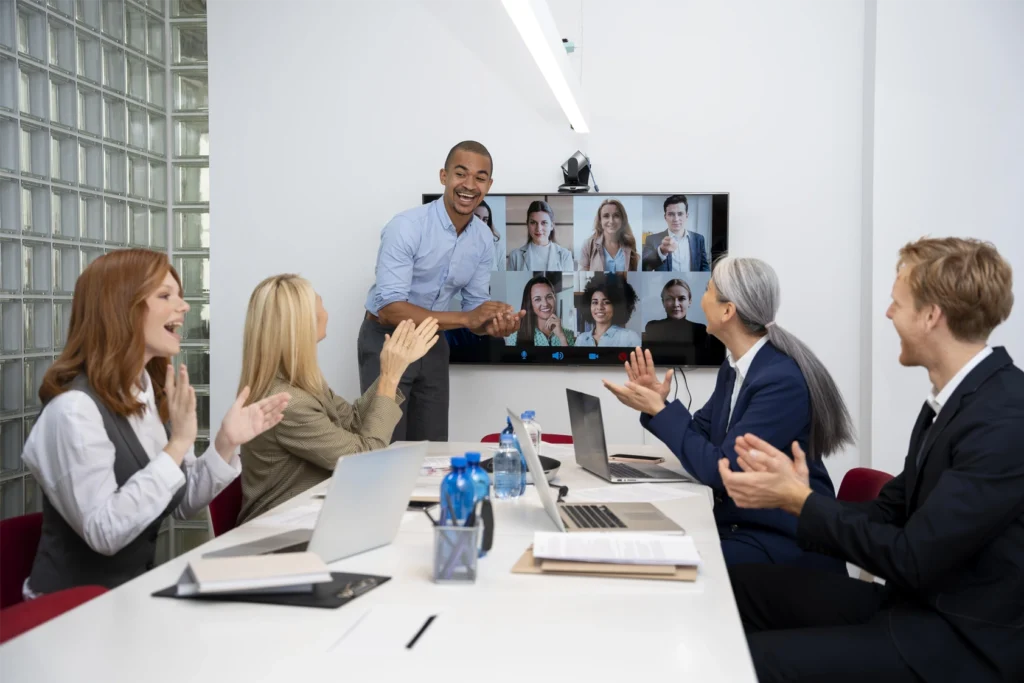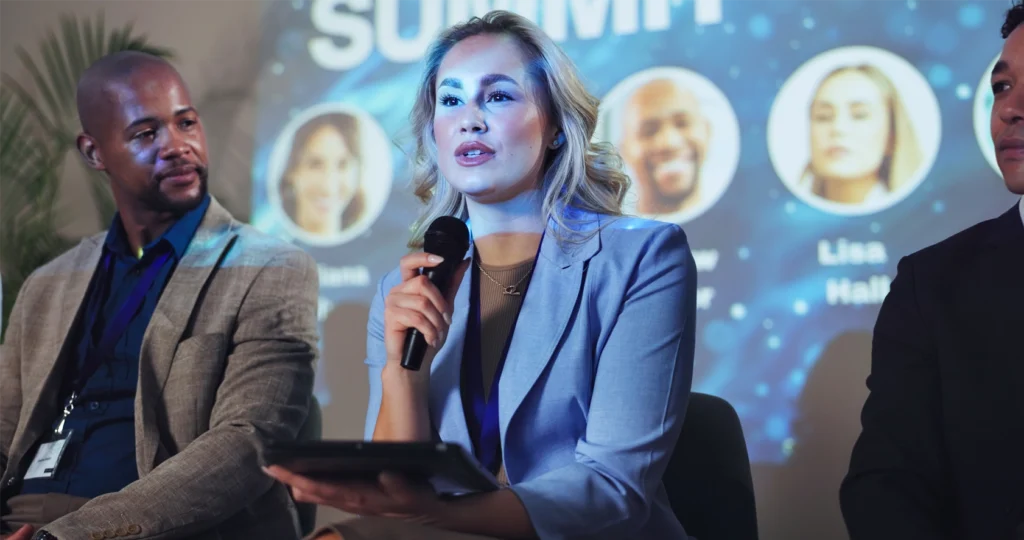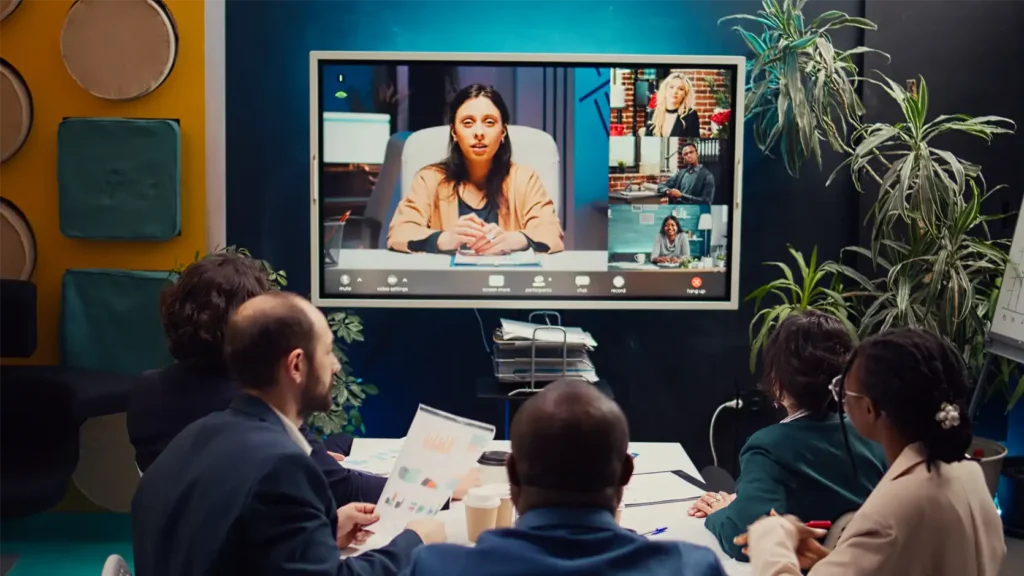
Why Webcasting Is Important for Your Global Business Expansion
- by GlobalMeet Blog Team
- ,
In today’s fast-moving global economy, expanding into international markets isn’t just an ambitious goal — it’s a strategic necessity. But with opportunity comes complexity, especially when it comes to managing communication across diverse time zones, languages, and cultures. That’s where webcasting steps in.
From web conference meetings to large-scale video webcasting, these technologies offer businesses the ability to securely communicate clearly, consistently, and cost-effectively across borders. Webcasting is no longer just a technical solution — it’s a strategic enabler for global business growth.
The Strategic Role of Webcasting in International Expansion
Global expansion means engaging customers, partners, and employees in multiple locations. In-person meetings are often impractical due to cost, time, and logistical hurdles. Webcasting bridges these gaps by enabling companies to deliver live and on-demand content to distributed audiences with minimal effort.
Overcoming Geographical Barriers
A traditional challenge for global businesses is how to communicate with distributed teams and external stakeholders in real time. Time zones, distance, and availability can all complicate even the most routine interactions.
Webcasting, along with hybrid and virtual events, offers a scalable solution to this problem. Companies can host live web conference meetings for instant collaboration, leverage on demand video webcasts for asynchronous viewing, or invest in hybrid events that combine in-person and online elements to ensure everyone can participate, regardless of location.
These tools make it easy to reach international teams, host multilingual events, and deliver consistent messaging to all markets simultaneously.
Supporting Key Business Events
Webcasting is not a one-size-fits-all tool — it’s a versatile platform that supports a wide range of strategic communication needs.
Town Hall Meetings
Global companies rely on regular town halls to align employees, build culture, and communicate strategic priorities. Webcasting allows leaders to speak directly to thousands of employees across the globe, either live or through recorded sessions that employees can watch on their own time.
R&D Days
Research and Development (R&D) efforts are increasingly collaborative and international. Webcasting enables researchers, engineers, and stakeholders from different countries to share updates, review data, and innovate in real time—without the delays and costs of travel.
New Product Introductions
Launching a new product globally requires a coordinated communications effort across sales, marketing, and customer service teams. Video webcasting makes it easy to train internal teams, build excitement with partners, and deliver product demonstrations to media and customers in multiple regions at once.
Reducing Travel Costs and Environmental Impact
Travel is expensive — not just in terms of cost, but also in time and carbon footprint. As businesses aim to meet both budget and sustainability goals, webcasting offers a compelling alternative to frequent international flights and large physical events.
Cost Savings from webcasting include:
- Lower airfare and accommodation expenses
- Fewer logistical costs related to venues, catering, and event staffing
- Reduced productivity loss from employee travel
The Environmental Benefits are equally compelling:
- Decreased carbon emissions from flights and ground transportation
- Smaller physical event footprints, which means less waste and resource usage
- Support for corporate sustainability goals and green certifications
These advantages make webcasting not only a smart financial decision but also a socially responsible one.
Key Features to Look for in a Webcasting Solution for Global Teams
Not all webcasting platforms are created equal — especially when it comes to supporting the needs of globally distributed teams. When choosing a solution, it is vital to consider several essential features.
Scalability
Whether you’re addressing 500 people or 100,000, your webcasting solution should handle large audiences without compromising quality or performance. Look for platforms that offer cloud-based scalability and global content delivery networks (CDNs).
Accessibility
A global audience includes people with different languages, abilities, and tech access. Your platform should offer:
- Multi-language support and live translation
- Mobile-friendly interfaces
- Screen reader compatibility
- Live audio-captioning
Security
When you’re sharing sensitive business information, security is non-negotiable. Choose a solution that offers:
- End-to-end encryption
- Role-based access control
- Compliance with global standards like GDPR, HIPAA, and SOC 2
Interactivity
Keep your global audience engaged with interactive features like:
- Live Q&A and polls
- Chat functions
- Real-time feedback tools
These features turn passive viewers into active participants, improving information retention and creating a sense of community across borders.
Analytics
Data is critical for continuous improvement. Look for solutions that offer robust reporting tools to track:
- Attendance and participation rates
- Engagement metrics (e.g., poll responses, chat activity)
- Viewing behavior (e.g., average watch time, drop-off points)
These insights can help you refine future webcasts and better serve your global audience.
How GlobalMeet Supports Global Business Growth
GlobalMeet is the leading webcasting and virtual event solution trusted by the Fortune 500. It is built specifically with global business needs in mind. It combines enterprise-grade technology with user-friendly design to deliver high-impact communication across international teams.
Secure and Compliant
GlobalMeet is designed to meet the highest standards of security and compliance, including GDPR, SOC 2, and ISO 27001, allowing you to host confidential internal meetings or high-profile public events without worrying about data breaches or compliance violations.
Scalable and Reliable
Whether you’re hosting a leadership town hall or a global product launch, GlobalMeet scales effortlessly to meet your needs. The platform is backed by a global CDN and cloud infrastructure, ensuring smooth streaming for audiences anywhere in the world.
Multi-Language and Accessibility Features
With support for real-time translation, closed captioning, and accessible interfaces, GlobalMeet ensures your message is clear and accessible — no matter who’s tuning in or where they are.
Enhanced Engagement
GlobalMeet offers a suite of engagement tools, from live polls, surveys, and Q&A to downloadable resources and branded event pages to help you keep global audiences connected and involved.
Actionable Analytics
Track the success of your webcasts with detailed analytics on viewer engagement, registration, and content performance. Use these insights to fine-tune future communications and better align with your strategic goals.
Conclusion
As companies increasingly expand into international markets, the need for seamless, scalable, and secure communication becomes critical. Webcasting plays a central role in this transformation — enabling real-time collaboration, cutting operational costs, and connecting global teams with clarity and consistency.
Whether you’re hosting a town hall for thousands of employees or launching a new product to markets worldwide, webcasting gives you the tools to scale your message without losing its impact.

How Law Firms are Educating, Engaging, and Growing by Leveraging Hybrid Event Technology Platforms
- by GlobalMeet Blog Team
- ,
The legal industry is undergoing a significant transformation. With increasing digitalization and evolving client expectations, law firms must find new ways to engage their audience while maintaining the personalized communication that fosters trust. Hybrid events provide a powerful solution, blending the convenience of virtual participation with the impact of in-person interactions.
By leveraging hybrid event technology platforms, legal firms can enhance client communication, increase engagement, and expand their reach beyond traditional in-person boundaries. This blog explores the benefits, types, best practices, and challenges associated with hybrid events for law firms, offering insights into how they can use this innovative approach to stay competitive in the modern legal landscape.
Why Hybrid Events Work in the Legal Sector
Increased Accessibility and Reach
Hybrid events enable law firms to connect with clients, prospects, and industry professionals regardless of location. Virtual components allow attendees to join sessions from anywhere, eliminating travel barriers and accommodating busy schedules. This extended reach is particularly beneficial for firms looking to establish a national or global presence.
Cost Effective Client Engagement
Hosting traditional in-person events can be expensive, requiring venue rental, catering, and travel expenses. Hybrid events reduce costs by allowing firms to invest in high-quality digital experiences while maintaining the option of in-person attendance for key stakeholders.
Enhanced Client Communication and Relationship Building
Hybrid events provide multiple touchpoints for client engagement. Interactive features such as live Q&A sessions, virtual networking rooms, and on-demand content help maintain ongoing communication. Personalized follow-ups based on attendee interactions further strengthen client relationships.
Improved Learning and Knowledge Sharing
Law firms often need to educate clients about legal changes, compliance requirements, and industry trends. Hybrid events make it easier to disseminate information through recorded sessions, expert Q&A panels, and digital resources that attendees can revisit at their convenience.
Data-Driven Insights
Hybrid event platforms provide valuable analytics, tracking attendee behavior, engagement levels, and session popularity. This data enables firms to refine their approach, tailor future events, and personalize follow-up communications.
Client Engagement Benefits of Hybrid Events
Effective client engagement is crucial for law firms to maintain trust and establish authority. Hybrid events offer unique advantages in this area:
- Personalized Experiences: Attendees can choose how they participate, creating a more flexible and customized experience. By offering multiple participation options—such as attending a live session, viewing a recorded version, or engaging in smaller discussion groups—law firms cater to different learning styles and availability constraints.
- Real-Time Interaction: Live chat, polls, and Q&A sessions keep audiences actively engaged. Hosting interactive discussions and allowing participants to ask questions in real-time fosters a more inclusive and engaging atmosphere, making virtual attendees feel equally involved.
- Multi-Channel Communication: Hybrid formats allow firms to leverage email, social media, and virtual platforms for outreach and engagement. Automated email reminders, follow-up surveys, and social media discussions can enhance client touchpoints before, during, and after the event.
- Stronger Connections: In-person components facilitate meaningful face-to-face discussions, while virtual options provide ongoing accessibility. Virtual networking lounges, breakout rooms, and AI-driven matchmaking can help remote participants connect with relevant peers and professionals, ensuring a well-rounded experience for all attendees.
Types of Hybrid Events for Legal Firms
Client Seminars and Webinars
Hybrid seminars educate clients on legal matters, such as regulatory updates, compliance requirements, and contract law changes. Firms can invite local clients to attend in person while broadcasting sessions online for a broader audience.
Continuing Legal Education Programmes
Offering CLE programs in a hybrid format allows legal professionals to participate in essential training remotely while still providing an in-person option for networking and discussions.
Panel Discussions and Roundtables
Expert-led discussions on trending legal topics can attract industry leaders, clients, and prospects. A hybrid format ensures maximum participation while maintaining an interactive experience.
Networking Events
Hybrid networking events combine physical meet-ups with virtual breakout rooms, fostering connections between lawyers, clients, and industry professionals.
Client Onboarding and Training
For firms handling corporate clients, hybrid training sessions can streamline onboarding processes, ensuring key stakeholders understand legal requirements and best practices.
Firm Open Houses and Thought Leadership Conferences
Hosting open houses or thought leadership events in a hybrid format enhances brand visibility and allows law firms to showcase their expertise to a wider audience.
Best Practices for Hosting Successful Hybrid Legal Events
Choose the Right Technology Platform
Selecting a reliable hybrid event platform is crucial. Key features to look for include:
- High quality live streaming
- Interactive tools such as polls, chats, and Q&A facilitation
- Networking capabilities
- Analytics and reporting tools
- On-Demand content options
Prioritize Audience Engagement
Keeping both in-person and virtual attendees engaged requires careful planning. Encourage participation for online participants through live questions and interactive elements so that they feel as valued as the people in the room. Use moderators to bridge the gap between physical and virtual audiences, and offer breakout sessions for those attending online to foster deeper communication.
Ensure Seamless Communication
Clear communication before, during, and after the event is vital. Provide detailed instructions on how to join and participate. Follow up with attendees through personalized emails, additional resources, and event recordings.
Invest in Quality Production
A professional setup with good lighting, sound quality, and camera angles enhances the virtual experience. Investing in a dedicated production team ensures smooth execution.
Integrate Networking Opportunities
Facilitating meaning connections is key to a successful hybrid legal event. Offer virtual networking lounges for delegates to meet one another, enable one on one video chats for more in depth conversations, and crate post-event discussion groups on social media to keep the conversations going long after the event has closed.
Gather and Utilize Feedback
Post-event surveys and analytics help measure success and identify areas for improvement. Use feedback to refine future hybrid events and enhance client engagement strategies.
Overcoming Common Challenges in Hybrid Events
Balancing In-Person and Virtual Experiences
Ensuring both audiences feel equally valued can be challenging. Solutions include hiring a virtual moderator, using interactive tools, and keeping online attendees actively involved.
Managing Technical Issues
Technical glitches such as missing video or audio quality drops can disrupt the event experience. Conduct test runs, have backup plans in place, and always choose a provider who can provide real-time tech support and production assistance to keep your events running smoothly.
Encouraging Virtual Participation
Virtual attendees are at risk of decreased engagement and digital fatigue. To counteract this, it is important to provide activities that keep them engaged. Use gamification techniques such as quizzes and rewards to keep them in the room. Offer incentives for active participation, and always keep online sessions concise and dynamic.
Measuring ROI and Success
Defining clear KPIs, such as attendee engagement, client inquiries, and follow-up interactions, helps measure the event’s impact, allowing you to build on lessons learned and run better and stringer events in the future.
Conclusion
Hybrid events are transforming how law firms educate, engage, and grow their client base. By blending virtual accessibility with in-person relationship-building, legal professionals can enhance communication, foster stronger connections, and expand their reach. Leveraging the right technology, best practices, and engagement strategies ensures hybrid events become a valuable asset in a firm’s marketing and client engagement toolkit.
As the legal sector continues to evolve, embracing hybrid events will be key to staying competitive and meeting the demands of a digital-first world.

Leveraging Technology to Create Accessible Event Experiences
- by GlobalMeet Blog Team
- ,
In today’s interconnected world, hosting accessible events is more than a practical responsibility — it is a business necessity.
Hybrid events, which contain in-person and virtual elements, have emerged as a powerful solution to ensure accessibility for all. Leveraging the right hybrid event software allows organizations to create experiences that engage broader audiences, and break down traditional barriers to participation.
By integrating advanced tools and thoughtful planning, organizations can expand the reach and impact of their events. Technologies such as auto-captioning, real-time translation, travel reduction, personalized participation, and assistive features all combine to build a culture of accessibility in every event.
Breaking Barriers with Auto-Captioning
Accessibility begins with understanding. For attendees with hearing impairments, or those participating in noisy environments, real time audio captioning is a game changer. By providing accurate subtitles or presentations, speeches, and power discussions, hydrant software ensures everyone can follow along effortlessly. Captions eliminate ambiguity, providing clarity for all participants, whether they are in a bustling convention hall or attending virtually from a crowded household.
This feature benefits a wider audience than one might expect. non-native speakers, individuals multitasking during virtual sessions, and attendees in less-than-ideal acoustic environments also find value in captions. According to the World Health Organization, by 2050 over 2.5 billion people are projected to live with some degree of hearing loss. Ignoring this significant demographic is a missed opportunity to engage a meaningful portion of your audience and demonstrate your organization’s commitment to that audience.
With advancements in AI technology improving every year, transcription tools can now offer highly accurate and real time captioning services. Allowing event organizers to meet accessibility standards while enhancing the overall event experience for all participants. Captioning also allows attendees to access transcripts after the event, making the content more accessible and ensuring its impact continues long beyond the live sessions.
Reaching a Global Audience with Auto-Translation
As organizations strive to expand their global reach, language barriers often pose a significant challenge. Hybrid Event Software with real-time auto-translation breaks down these barriers by converting spoken or written content into multiple languages on the fly. This ensures that attendees from different linguistic backgrounds can follow and contribute to the conversation without feeling left out. By speaking in many languages simultaneously, events foster a truly global sense of community.
Auto translation tools use sophisticated algorithms and natural language processing to provide accurate translations for live sessions, chat messages, and supporting materials. So, you can host in English, while participants from Tokyo to Switzerland can follow along in their native languages. This capability not only increases accessibility, but opens the doors to new markets and fosters international collaboration.
Auto translation can also enhance networking opportunities. Platforms with enabled translation in chat and messaging features empower attendees to connect with peers and professionals from around the globe without the barrier of language. Events become more accessible, welcoming professionals who might otherwise be excluded due to linguistic differences.
Reducing Travel for Greater Participation and Sustainability
Travelling to an event can be time-consuming, expensive, and sometimes outright impossible for many individuals. By enabling virtual attendance, hybrid events significantly reduce the need for physical travel, making participation more accessible for those with limited mobility, tight budgets, or geographical constraints. Attendees can join from anywhere, offering unparalleled flexibility and opportunity.
In addition to fostering participation, reducing travel has a measurable positive impact on the environment. In January 2025, the International Energy Agency reported that aviation accounted for 2.5% of global CO2 emissions. By giving attendees the option to join remotely, organizations can contribute to sustainability while meeting the growing demand for eco-conscious practices.
Hybrid events also accommodate those who face challenges like caregiving responsibilities, all work commitments, offering flexibility to join sessions at their own convenience. For many professionals balancing complex schedules this flexibility makes participation possible. Furthermore, reduced travel requirements open the door to younger aspiring professionals who may not yet have the financial means to attend traditional in-person events.
Enhancing Engagement with Personalized Participation
Hybrid event technology also promotes engagement by enabling customized participation options. Hybrid platforms allow attendees to build personalized schedules, join specific breakout sessions, and access on demand content, all tailored to their preferences and needs. For instance, someone joining virtually may prefer smaller, interactive Q&A sessions or a particular time zone friendly schedule, while an in-person participant might choose a networking-focused agenda. This adaptability ensures every participant feels their experience is thoughtfully designed.
By designing experiences that adapt to individual needs, organizers foster a greater sense of satisfaction among attendees. Flexible programming encourages engagement, leaving participants feeling valued and eager to participate in future events. The ability to revisit recorded content ensures everyone has the time and opportunity to fully absorb the events materials and messages, reinforcing the value of a hybrid model.
Assistive Features for Diverse Needs
Inclusivity isn’t a ‘one-size-fits-all’ approach. Beyond captioning and translation, hybrid event software can include assistive features such as live captioning, playback, and transcription as standard. These tools address the specific needs of attendees with visual impairments, cognitive differences, or other disabilities.
By integrating these features, organizers send a clear message: everyone is welcome. Assistive technologies not only comply with accessibility standards, like the Web Content Accessibility Guidelines, but also enhance the user experience for a broader audience. Events that cater to broader accessibility needs create an environment of participation that goes beyond the virtual screen or event hall, setting a precedent for cooperation and collaboration.
These features are also incredibly valuable for neurodivergent individuals. Providing clear navigation, predictable layouts, and easy to use controls ensures those with Autism, ADHD, or other cognitive conditions can comfortably participate. As awareness around these needs grows, event platforms proactively addressing these issues will be better equipped to lead in the marketplace.
Conclusion
The rise of hybrid events has unblocked unparalleled opportunities to make gatherings more accessible to more people. Features like auto captioning, real time translation, reduced travel requirements, personalized participation, and assistive tools are transforming the way organizations engage with their audiences.
By embracing these technologies and cultivating an accessible event culture, businesses not only enhance the attendee experience but also demonstrate a commitment to accessibility. The result? Events that are not just more successful but also more impactful, connecting people from around the world.
Accessible hybrid events are not just the future, they are the present. By using the right tools and fostering an accessible mindset, you can create events that inspire, engage, and succeed, every single time.

Elevating Safety and Connection: Hybrid Events for Senior Leadership
- by GlobalMeet Blog Team
- ,
In an era where senior executives are navigating increasing time constraints and evolving risks, hybrid events are emerging as a strategic solution that marries safety with meaningful stakeholder engagement. These events, which combine in person and virtual participation, offer executives the flexibility to connect without compromising security or effectiveness. By exploring the potential of hybrid formats, businesses can ensure a balanced approach to corporate safety strategy and impactful communication.
Hybrid events aren’t just a response to current challenges — they represent an evolved approach to leadership visibility, stakeholder communication, and event execution. As organizations prioritize safety without wanting to dilute the value of personal connections, hybrid models present themselves as adaptable and efficient mechanisms for maintaining relevance and operational resilience.
Balancing Safety and Connection
Senior leadership plays a pivotal role in maintaining strong relationships with stakeholders, serving as the face and driving force behind an organization’s strategic direction. However, public appearances often come with heightened safety considerations and logistical challenges. These concerns can limit the ability of executives to engage widely and effectively. Hybrid events bridge this gap by enabling executives to balance accessibility with security, providing a platform to engage stakeholders both locally and globally in a manner that is both impactful and secure. By combining the best of in-person and virtual formats, hybrid events empower executives to expand their reach, amplify their message, and address the dynamic needs of their audience without taking on unnecessary risks.
Leverage both in-person and virtual formats
This dual approach allows leaders to maintain personal connections while reducing physical risks. Whether it’s addressing a local audience or reaching international stakeholders, hybrid events offer scalable options for every scenario.
Enhance stakeholder relationships
With seamless integration of virtual and physical elements, executives can connect with audiences across the globe without sacrificing quality or engagement. Virtual elements facilitate on-demand content delivery, ensuring greater inclusivity for diverse time zones.
Mitigate risks in public settings
By offering an alternative to in person attendance, hybrid events reduce the likelihood of exposing leadership to physical threats or health risks. Risk management strategies can be seamlessly integrated into the design and execution of such events, offering flexibility without compromising efficacy.
Advantages of Hybrid and Virtual Events
Hybrid and Virtual Events provide a unique opportunity to elevate corporate risk management strategies whilst amplifying engagement. By enabling real time adaptation to challenges and integrating innovative tools, these formats demonstrate unparalleled versatility and advanced capabilities. From fostering high quality connections to addressing complex security and logistical needs, hybrid events serve as a cornerstone for modern leadership strategies, and continue to redefine engagement.
Remote Participation without Compromising Visibility
Senior executives can join events from any location, ensuring their presence and input are felt without the need for travel or physical attendance. This enhances flexibility and allows for increased participation, even when schedules are tight.
Cutting Edge Technology
Tools such as live streaming, interactive Q&A sessions, and virtual networking platforms enable meaningful interactions that mirror in person experiences. Attendees can engage with senior leadership seamlessly, fostering trust and report. High quality video, live captioning, and translation tools further enrich accessibility and the event experience.
Global Reach and Accessible Access
Hybrid formats remove geographical barriers, enabling broader participation and enhanced inclusivity whilst reducing time and resource constraints. This means audiences and stakeholders can attend without logistical challenges, promoting accessibility and engagement at scale.
Customizable security solutions
The adaptable nature of hybrid events lends itself to advanced security measures, ensuring the protection of both executives and vital communications.
Flexibility to Respond in Real Time
Hybrid formats allow adjustments based on situational needs, such as changing public health policies or unforeseen security challenges. Organizers can adapt attendance protocols, venue logistics, or online setups dynamically to address any emerging concerns.
Enhanced Cybersecurity
By leveraging robust virtual event platforms, businesses can protect sensitive communications from threats like cyber-attacks or unauthorized access. Advanced encryption and multifactor authentication ensure secure connections, while backup systems guarantee continuity of communications even in the face of disruptions.
Scalability and Resilience
From small team meetings to global summits, hybrid platforms can accommodate varying scales while upholding the highest security standards. Tailored solutions allow events to scale efficiently while remaining prepared for potential threats, both virtual and physical
Planning for the Future of Corporate Events
Hybrid and virtual event formats represent more than a short-term solution. They are shaping the future of corporate gatherings. By integrating safety, flexibility and connectivity, business can make sure that they stay relevant and up to date.
Invest in long term solutions
Adopting hybrid events as a standard practice supports ongoing risk mitigation whilst fostering deeper connections with stakeholders Building permanent infrastructure around hybrid models ensures readiness for any eventuality.
Streamline Risk Management through Technology
Advanced event technology enables real-time monitoring and response, ensuring a proactive approach to event safety. Predictive analysis can assess risks and inform decision-making before and during events.
Futureproof Corporate Engagement
As global challenges evolve, hybrid and virtual platforms provide a resilient framework for ongoing communication and collaboration. Embracing these models will position organizations as forward thinking and adaptive to change, securing their leadership role in complex and uncertain environments.
Long term planning can also facilitate integration with emerging trends such as AI driven participant engagement, or carbon offsetting in event planning, promoting not only safety but sustainability and technological sophistication.
Conclusion
Hybrid events offer an innovative pathway for senior leadership to manage the delicate balance between safety and connection. By harnessing the power of virtual and in person integration, executives can effectively navigate today’s challenges while building meaningful relationships. These formats present an opportunity for organizations to rise to the occasion by demonstrating agility, foresight, and a commitment to excellence.
Embracing this dynamic approach ensures that safety and engagement remains central to corporate strategies, paving the way for a connected and secure future. Hybrid events — where safety meets innovation — are defining the future of leadership communication, ensuring organizations remain adaptable and impactful in an ever-changing landscape.

Transforming Corporate Communications: Leveraging Virtual and Hybrid Events for Success
- by GlobalMeet Blog Team
- ,
In the evolving corporate landscape, the importance of effective communication has never been more pronounced. Organizations face the dual challenge of maintaining internal alignment and fostering stakeholder engagement in a rapidly changing and increasingly digital world. Virtual and hybrid events have emerged as transformative tools, seamlessly blending technology and innovation to redefine corporate communications.
The Role of Virtual and Hybrid Events in Modern Corporate Communications
Redefining Accessibility and Engagement
Virtual corporate events and hybrid corporate events are not just convenient; they represent a paradigm shift in how businesses connect with their audiences. They offer unique advantages:
- Cost Efficiency: Virtual events eliminate expenses associated with travel, accommodation, and venue rental. Hybrid events allow a tailored allocation of resources, focusing in-person investments where they matter most while leveraging virtual technology for broad outreach.
- Global Reach: A hallmark of hybrid corporate events is their ability to create a “global bridge” between their teams all over the world. By using advanced platforms such as GlobalMeet, companies can link physical gatherings with remote participants who can interact seamlessly through chat, polling, surveys, and live Q&A sessions.
- Scalability: Virtual and hybrid formats can scale to accommodate audiences of any size, from small internal meetings to global conferences, ensuring maximum reach without compromising quality.
Strengthening Internal Corporate Communications
Effective corporate communication strategies are pivotal for employee engagement, alignment with organizational goals, and cultural cohesion. Virtual town halls and hybrid formats revolutionize internal communications by:
- Enhancing Inclusivity: Virtual town halls ensure that every employee, regardless of location, receives the same information simultaneously.
- Encouraging Real-Time Interaction: Features like live Q&A sessions and interactive polling provide immediate feedback and foster dialogue, making employees feel valued and heard.
- Streamlining Information Dissemination: Virtual AGMs (annual general meetings) and other corporate gatherings allow organizations to share updates directly, ensuring clarity and consistency across all levels.
Crisis Communications: Navigating Challenges with Virtual Events
A well-crafted crisis communications strategy is essential for mitigating reputational risks and ensuring business continuity. Integrating virtual events into this strategy amplifies organizational agility and responsiveness during crises.
Virtual platforms enable businesses to:
- Respond Swiftly: In a crisis, speed is paramount. Virtual events allow organizations to address stakeholders directly, providing updates and guidance in real time.
- Maintain Transparency: Sharing live video updates with stakeholders humanizes the message and establishes trust, critical during tumultuous times.
In a recent webinar GlobalMeet President Michele Dobnikar discussed the importance of communications as part of a good crisis management strategy, and how it can make or break business continuity in a crisis. She gave the example of a recent wildfire crisis, where proactive testing of a company’s business continuity plan allowed uninterrupted operations while ensuring employee safety.
Leveraging virtual events in such situations allows for immediate communication, ensuring that teams remain informed and stakeholders reassured.
Maximizing Engagement and Participation
Ensuring active participation in virtual corporate events is crucial to their success. With the shift towards more digital interactions, organizations need to adopt thoughtful strategies that encourage dynamic participation and create value for attendees.
Utilizing Interactive Tools
Interactive tools play a critical role in fostering engagement during virtual and hybrid corporate events, making them dynamic and memorable.
- Live Polls and Surveys: These tools collect audience feedback and encourage involvement, offering valuable insights into participant preferences and opinions.
- Q&A Sessions: Enable participants to interact directly with presenters, promoting a two-way communication channel that ensures audience queries are addressed promptly.
- Gamification Elements: Incorporate activities like quizzes, contests, or interactive challenges to create an engaging and fun environment that keeps participants motivated.
- Breakout Rooms: Facilitate small group discussions and networking opportunities, simulating face-to-face interactions and fostering deeper connections among attendees.
Measuring Success through Metrics
Analyzing the effectiveness of virtual and hybrid corporate events is essential for continual improvement and demonstrating value to stakeholders. Success can be measured using various metrics that provide actionable insights:
- Attendance Rates: Tracking the number of attendees against registration numbers helps gauge the event’s overall appeal and marketing effectiveness.
- Participant Engagement: Tools like chat logs, poll responses, Q&A participation, and survey completions can highlight the audience’s interaction levels.
- Session Analytics: Evaluating which sessions had the most participation or retained audiences for the longest periods indicates what topics resonated most.
- Feedback Surveys: Post-event surveys are invaluable for gathering qualitative data on attendee satisfaction, speaker performance, and potential improvements.
- ROI Analysis: By comparing costs against the value generated—such as new leads, client retention, or employee satisfaction—organizations can assess the direct benefits of the event.
These metrics provide an empirical basis for refining future events, tailoring content, and enhancing engagement strategies. A detailed analysis of metrics such as attendance, participant interaction, and post-event surveys helps organizations refine their approach and measure ROI effectively.
Future Trends in Virtual and Hybrid Corporate Communications
The evolution of virtual and hybrid events is closely tied to emerging technological and environmental trends. Organizations that stay ahead of these trends will position themselves as innovators in corporate communications.
Technological Advancements
- AI and Automation: Artificial intelligence is enhancing personalization by tailoring content to individual attendee preferences and automating routine event management tasks, such as scheduling and follow-ups. AI-powered chatbots can also provide real-time assistance during events, ensuring a smoother user experience.
- Immersive Experiences: The integration of augmented reality (AR) and virtual reality (VR) technologies is revolutionizing attendee engagement. These tools create dynamic and lifelike environments where participants can explore virtual exhibition booths, attend immersive keynote sessions, or collaborate in virtual meeting spaces. Additionally, 360-degree video capabilities enhance remote participants’ sense of presence, making them feel as though they are part of the in-person experience.
With these advancements, the future of virtual and hybrid corporate communications is primed for increased interactivity, personalization, and accessibility, setting the stage for richer and more meaningful connections across audiences.
Conclusion
Virtual and hybrid events are no longer just options but essential components of a robust corporate communications strategy. From virtual town halls to hybrid annual general meetings, these tools facilitate effective internal and external communication, crisis management, and sustainable engagement. By leveraging emerging technologies and fostering interaction through innovative platforms, businesses can transform their communication strategies to align with the demands of a digital-first world.
As organizations continue to adapt, the integration of virtual and hybrid events promises to redefine success in corporate communications, ensuring seamless connectivity, enhanced engagement, and sustained trust with stakeholders worldwide.

From “Fake Paper” to Real Impact: Making Digital and Hybrid Events Feel Tangible
- by GlobalMeet Blog Team
- ,
In today’s rapidly evolving events landscape, the rise of digital and hybrid events has introduced unparalleled opportunities for global connection and innovation. Yet, a critical challenge persists: how do we make these virtual experiences feel genuine, impactful, and tangible — rather than just another “fake paper” placeholder in the world of event engagement? Here’s a deep dive into strategies that transform virtual and hybrid events from superficial to significant.
Understanding the "Fake Paper" Phenomenon
The term “fake paper” captures a sentiment many attendees feel during digital events. Virtual handshakes lack warmth; screens replace the spontaneity of real-world encounters. In this context, digital events can feel intangible, even insignificant. Much like fake paper — an empty simulation of the real thing — they run the risk of being overlooked or undervalued.
This sense of superficiality stems from the lack of depth and authenticity. Attendees often crave more than mere visual or auditory cues; they miss the tactile, emotional aspects of traditional events. The weight of a name tag, the excitement of mingling over coffee, the dynamic exchanges in hallway chats, and the shared energy of applause create memories and connections that stay with attendees long after the event ends. Without these layers of experience, digital events risk becoming disposable, a blur of screens rather than meaningful moments.
To bridge this gap, planners must look beyond the confines of technology as a transactional medium and strive to make digital and hybrid events feel personal, emotionally resonant, and undeniably real. This requires thoughtful integration of tools and strategies that prioritize meaningful interactions, as well as a commitment to creating shared experiences.
Creating Depth and Authenticity
To move beyond the superficial, event organizers must prioritize depth and authenticity. Here are several key approaches:
Leveraging Technology for Tangible Experiences
Advancements in technology allow digital events to simulate real-world sensations and interactions.
Virtual Reality (VR) and Augmented Reality (AR): These tools create immersive environments where attendees can explore virtual venues, engage with booths, or attend breakout sessions as if they were physically present. These technologies replace static 2D experiences with dynamic, exploratory spaces, making attendees feel part of the action.
Physical-to-Digital Bridges: Send physical event kits with tactile items — such as branded merchandise, snacks, tools for interactive workshops, or even sensory objects that tie into the event theme — ahead of the event. The anticipation and engagement with these kits can anchor the digital experience in something tangible.
Sensory Technology: Incorporate haptics or audio-visual enhancements to engage multiple senses, such as vibration feedback during an AR experience or 3D audio that simulates realistic spatial soundscapes. Sensory depth enhances immersion and makes digital interactions memorable.
Gamification and Interactivity
Gamification transforms passive participation into active engagement, fostering a sense of fun and competition that attendees can enjoy across both digital and physical spaces.
- Introduce leaderboards, challenges, or live quizzes that reward attendees with incentives such as event-branded prizes or charitable donations in their name.
- Utilize tools like scavenger hunts that connect physical and virtual elements. For instance, attendees can unlock clues in an app by completing both on-site and digital activities.
- Implement virtual escape rooms or trivia tournaments, encouraging collaboration and interaction. Structured games make every moment of participation feel purposeful.
By incorporating such elements, digital events can cultivate camaraderie and creativity, transforming isolated experiences into interactive and enjoyable ones.
Bridging the Digital-Physical Divide
Hybrid events offer a natural opportunity to connect the digital and physical realms. To maximize impact. Creating seamless hybrid experiences requires attention to both logistics and user experience.
- Utilize simultaneous live streams and interactive video conferencing to promote real-time collaboration. Ensure that the quality of engagement is consistent for both audiences, minimizing feelings of exclusion.
- Organize shared experiences, such as interactive keynote sessions, where attendees across locations can contribute questions, vote in polls, or see their input reflected instantly. Consider unifying platforms that handle both in-person and virtual audiences, reducing friction.
- Design interactive elements, such as custom event apps or on-site VR booths, that enable remote attendees to participate in activities like live product demonstrations.
Networking That Feels Real
Networking is a cornerstone of any event, yet virtual networking often feels contrived. To combat this:
- Leverage AI tools to match attendees based on shared interests, backgrounds, or career goals, enabling curated one-on-one meetings that mimic chance encounters.
- Host casual networking sessions using structured formats, such as speed networking, peer-to-peer interviews, or small topic-focused breakout discussions. These allow for targeted, meaningful conversations.
- Create virtual communal spaces, such as lounges designed with interactive widgets like avatar-based games or opportunities for co-creating whiteboard ideas, to mimic the lively, unstructured flow of real-world mingling.
Hybrid networking succeeds when it enables attendees to forge genuine connections—whether they’re on-site or online.
Buzzworthy Trends Shaping Virtual Engagement
To elevate digital and hybrid events from functional to exceptional, event planners must embrace emerging trends:
Personalization
Gone are the days of one-size-fits-all content. Attendees now expect tailored experiences that make them feel seen and valued.
- Use registration data to create customized agendas tailored to individual interests, skill levels, or learning goals. Provide options to personalize even within sessions, such as advanced breakout rooms for interactive discussions.
- Deliver personalized follow-ups, such as curated session recommendations, actionable resources, and targeted networking opportunities. When attendees feel directly acknowledged, engagement deepens.
Sustainability
Virtual and hybrid events already reduce carbon footprints by eliminating travel requirements, but planners can amplify the sustainable impact:
- Replace physical collateral with visually appealing digital brochures and handouts.
- Opt for green hosting services that prioritize renewable energy, and highlight these efforts in event messaging.
- Include sustainability discussions, such as workshops on actionable climate initiatives, fostering awareness among attendees.
Immersive Technology
Cutting-edge technology takes engagement to the next level.
- Invest in virtual platforms that replicate real-world dynamics, creating cohesive event universes with lifelike graphics, textures, and environments.
- Incorporate holographic displays that make it possible for speakers or performers to appear in multiple locations simultaneously, reducing travel while still delivering a personal touch.
- Use AI-driven interactions, such as conversational chatbots or real-time content recommendations, that mimic human-like spontaneity.
Boosting Engagement Through Feedback and Metrics
Engagement is the metric that separates “fake paper” events from impactful ones. An iterative approach informed by data ensures events evolve to feel increasingly authentic and resonant.
- Analyze metrics such as session attendance, interaction rates, social media mentions, and post-event survey data. By integrating these findings, planners can understand what worked well and what requires improvement.
- Monitor engagement trends within virtual platforms. Heatmaps tracking movement or clicks can reveal how audiences engage with interactive content, indicating which areas felt most dynamic.
- Gather qualitative feedback via direct interviews or focus groups. Personal anecdotes and observations often uncover emotional insights that raw data might miss.
Building future events on these learnings ensures continuous enhancement of their tangibility and depth.
Pitfalls to Avoid
To ensure digital and hybrid events truly resonate:
Avoid Overcomplicating Technology:
Complex platforms can frustrate users. Prioritize intuitive tools over flashy but confusing interfaces, especially when engaging diverse audiences.
Don’t Skimp on Production Quality:
Subpar audio, video, or unstable internet streams can undermine credibility. High production values signal professionalism and enhance attendee confidence.
Resist Ignoring Personal Connection:
Technology should enhance, not replace, human interaction. Create opportunities for empathy, surprise, and genuine moments of shared enthusiasm.
Conclusion
While digital and hybrid events risk feeling intangible, event planners possess powerful tools to create authentic, impactful experiences. By combining technological innovation, interactivity, and a human-centric approach, you can bridge the gap between the digital and physical, turning “fake paper” into something profoundly meaningful. The future of events lies in their ability to feel real — wherever attendees may be. Through thoughtful design, innovation, and personalization, digital and hybrid events can leave lasting impressions that matter.

Mastering 2025: Elevate Your Event Strategy with Virtual and Hybrid Innovations
- by GlobalMeet Blog Team
- ,
As we approach 2025 the events industry is on the cusp of a dynamic transformation. With increasing emphasis on accessibility, sustainability, and inclusivity, event planners must embrace innovative formats to stay ahead. Virtual and hybrid event models are leading the charge, offering unparalleled opportunities to reach broader audiences while aligning with modern values. By adopting these strategies, you’ll not only meet the needs of today’s audiences but also future-proof your events. Let’s delve into actionable strategies to elevate your event planning by leveraging these formats effectively.
Broadening the Reach of Your Events
One of the most compelling advantages of virtual and hybrid events is their ability to make experiences more accessible to diverse audiences. By breaking down physical and geographical barriers, these formats enable participation for those who might otherwise be excluded.
Assistive Technologies: Implementing tools such as closed captioning, sign language interpretation, and screen reader compatibility ensures that your events cater to individuals with disabilities. Real-time translations can also bridge language barriers, opening your event to global audiences.
Customizable Participation: Virtual platforms can provide adaptable viewing and interaction options, accommodating various time zones, preferences, and needs. Offering downloadable materials, recorded sessions, and live Q&A opportunities further enriches the attendee experience. Tailor content for different demographics to make your event widely appealing.
By prioritizing accessibility, you’ll not only expand your audience but also foster inclusivity and goodwill. An accessible event is a clear statement that your brand values everyone’s participation.
Hosting Eco-Friendly Events
In an era of environmental consciousness, sustainability should be central to your event strategy. Virtual and hybrid formats inherently reduce the carbon footprint associated with traditional in-person gatherings. Consider these key practices:
Carbon Reduction Metrics: Eliminate the environmental impact of mass travel by enabling remote attendance. Promote public metrics showcasing reduced CO2 emissions from your virtual event to demonstrate your commitment to sustainability. Incorporate renewable energy sources in any physical venues used.
Paperless Solutions: Go fully digital with event brochures, schedules, and promotional materials to minimize waste. Platforms with integrated apps and QR codes can streamline these efforts and encourage attendees to embrace digital interactions.
Hybrid Event Optimization: For hybrid setups, incorporate local hubs or regional meetups to reduce extensive travel while maintaining in-person elements for engagement. Collaborate with eco-friendly vendors to source sustainable materials for physical components of the event.
Sustainable events are not only better for the planet but also appeal to environmentally-conscious audiences, enhancing your brand’s reputation with those key groups. Engage participants by sharing stories of your sustainability efforts to foster community support.
Cost Efficiency: Scaling Your Budget
Virtual and hybrid events also offer substantial cost savings compared to traditional formats. With fewer logistical requirements, these models maximize the impact of every dollar spent.
Travel and Accommodation Savings: By reducing or eliminating the need for travel, accommodation, and physical venues, organizations can allocate resources to other priorities such as enhancing content, marketing, or tech solutions. For hybrid events, selecting regional venues minimizes travel expenses while retaining live components.
Scalable Formats: Virtual platforms can accommodate massive audiences without the need for additional space or complex logistics, allowing cost-efficient scalability. Instead of increasing costs, focus on enhancing the quality of your digital delivery to make every attendee feel valued.
A cost-effective approach doesn’t mean compromising quality. Redirect your savings towards improving attendee experience and achieving higher ROI. Invest in interactive tools and analytics to better understand and serve your audience.
Connecting Global and Diverse Audiences
Hybrid and virtual formats allow you to design events that truly embrace inclusivity—creating spaces where everyone feels represented and valued.
Catering to Varied Needs: A hybrid setup ensures that both in-person and online attendees have equitable access to event content. Incorporate real-time audience interaction via chatrooms, polls, and Q&A sessions to encourage active participation. Include culturally relevant content and diverse speakers to reflect a broader range of perspectives.
Fostering Community: Virtual breakout rooms, networking sessions, and dedicated discussion channels enable deeper connections among attendees. These elements help establish a sense of belonging and shared purpose. Platforms with AI-powered matchmaking can connect participants based on shared interests, further enhancing the networking experience.
Inclusivity in event planning not only improves audience satisfaction but also positions your brand as forward-thinking and culturally aware. Celebrate diversity to resonate with audiences worldwide and amplify your impact.
Maximizing ROI: Turning Events into Long-Term Value
Virtual and hybrid formats are designed to drive measurable returns, from lead generation to future content creation.
Lead Generation and Brand Visibility: Digital events naturally capture comprehensive attendee data, providing valuable insights for future campaigns. Use these metrics to refine your marketing strategies and improve overall ROI. Gamify engagement during events to increase participation and collect more actionable insights.
Future Content Opportunities: Recorded sessions and presentations can be repurposed into evergreen content such as webinars, eBooks, or promotional materials, creating additional touchpoints for engagement. Highlight key moments from live streams as teaser content for social media, extending the visibility of your brand.
By leveraging the data and content generated during your events, you can extend their impact far beyond the event’s closing day. Share analytics with stakeholders to demonstrate the value of your investment.
Flexibility and On-Demand Content: Extending the Event Lifespan
The modern audience values flexibility. Offering on-demand content ensures your event remains relevant and accessible long after its initial execution.
Lifetime Access: Recorded sessions enable attendees to revisit key insights or share them with their network. This feature also attracts potential attendees who can’t participate in real-time. Consider offering premium packages that include extended access to exclusive content.
Global Engagement: On-demand content bridges geographical and time-zone divides, making your event a truly global experience. Supplement recordings with discussion forums or follow-up webinars to sustain engagement long after the live event ends.
This flexibility not only enhances attendee satisfaction but also increases the longevity of your event’s influence. Use ongoing engagement strategies to turn one-time participants into long-term advocates for your brand.
Practical Tips for Building Your 2025 Event Strategy
Experiment with Formats: Explore hybrid models by combining live sessions with on-demand options to cater to diverse audience preferences. Regularly survey attendees to understand their changing needs.
Invest in Technology: Choose platforms that prioritize usability and include built-in analytics, interactive features, and robust security measures. Ensure your platform is scalable and can handle global audiences effectively.
Focus on Design: Curate user-centric designs for digital experiences to encourage engagement and reduce friction. Enhance visual appeal by incorporating custom branding elements and interactive interfaces.
Enhance Networking Opportunities: Leverage AI-powered matchmaking tools or scheduled networking sessions to foster meaningful connections. Consider creating tiered networking opportunities for deeper, tailored engagement.
Highlight Social Impact: Share stories about the inclusive and sustainable impact of your event to build brand loyalty and community trust. Engage participants in live sustainability challenges to make a tangible impact.
Be Ready for 2025: Innovate Your Events
The events landscape is undergoing rapid evolution, and the time to adapt is now. By embracing the power of virtual and hybrid formats, you can deliver accessible, sustainable, and inclusive experiences while maximizing your ROI and extending the reach of your brand.
As 2025 approaches, the key to success lies in your ability to combine strategic planning with cutting-edge technology. Begin incorporating these innovations into your event strategy today to lead the way into the future of impactful, scalable events. With the right approach, your events won’t just meet expectations—they’ll redefine them.

Sustainable Event Planning for B Corporations
- by GlobalMeet Blog Team
- ,
In today’s rapidly evolving corporate landscape, sustainability has transitioned from a buzzword to a critical component of business operations. For B Corporations (B Corps), which are companies certified for meeting high standards of social and environmental performance, sustainability isn’t just an option — it’s a core value. As B Corps strive to balance profit with purpose, incorporating sustainable event planning into their communication strategies is a powerful way to align with their certification goals. Sustainable event planning not only contributes to environmental stewardship but also enhances brand reputation and stakeholder engagement.
The Growing Importance of Sustainable Event Planning
Sustainable event planning, or sustainable event management, has gained traction globally as more companies recognize the environmental impacts of traditional event practices. Supported by worldwide and federal initiatives, businesses are increasingly investing in sustainability across all aspects of their operations, including events. This shift is particularly significant for B Corps, which are committed to using business as a force for good. By embracing sustainability at events, B Corps can further demonstrate their dedication to positive environmental and social impacts.
The importance of event sustainability is underscored by the significant resources typically consumed by in-person events, including energy, materials, transportation, and waste. Traditional events often leave a considerable carbon footprint, from travel emissions to disposable materials. By contrast, sustainable event planning focuses on minimizing these impacts through careful planning and the adoption of environmentally friendly practices.
Leveraging Virtual and Hybrid Events for Sustainability
One of the most effective strategies for reducing the environmental impact of events is the use of virtual and hybrid event platforms. These platforms allow companies to host events online or combine in-person and virtual elements, significantly reducing the need for travel and the associated carbon emissions. For B Corps, this approach aligns with the certification requirements to minimize environmental harm and contribute to a more sustainable future.
Virtual events eliminate the need for participants to travel, thus reducing transportation-related carbon emissions. Additionally, they reduce the need for physical materials, such as printed programs, signage, and disposable items, all of which contribute to waste. By transitioning to virtual platforms, B Corps can significantly decrease their events’ carbon footprints while maintaining high levels of engagement and interaction with their audience.
Hybrid events, which combine in-person and virtual elements, offer a middle ground. They allow companies to host smaller, localized gatherings while reaching a broader audience online. This approach reduces the environmental impact by limiting the number of attendees who need to travel, while still providing the in-person experience that many participants value. Moreover, hybrid events can be more cost-effective, as they reduce the need for large venues and extensive on-site resources.
Meeting B Corp Certification Requirements Through Sustainable Events
For B Corps, incorporating sustainable event planning is not just beneficial — it is essential for meeting the rigorous standards of the B Corp certification. The certification process evaluates companies on their social and environmental performance, accountability, and transparency. Reducing carbon emissions and minimizing environmental impact are key components of this evaluation.
By opting for more virtual and hybrid events instead of solely in-person gatherings, B Corps can effectively reduce their transportation impacts, which is a critical factor in achieving lower carbon emissions. This strategy is particularly relevant as global awareness of climate change and the need for action continues to grow. B Corps are uniquely positioned to lead by example in this area, demonstrating that it is possible to host impactful, engaging events without compromising on sustainability.
Practical Tips for Sustainable Event Planning
1. Choose Virtual and Hybrid Formats:
Opt for virtual or hybrid events whenever possible to minimize travel and reduce carbon emissions. Virtual platforms offer advanced features such as networking opportunities, live Q&A sessions, and interactive workshops, ensuring a high level of participant engagement.
2. Select Sustainable Venues:
When in-person events are necessary, choose venues that prioritize sustainability. Look for venues that use renewable energy, have efficient waste management systems, and are accessible by public transportation.
3. Use Digital Materials:
Replace printed materials with digital alternatives. Event apps, online agendas, and digital tickets reduce paper waste and are more convenient for attendees.
4. Promote Sustainable Transportation:
Encourage attendees to use public transportation, carpool, or cycle to the event. Providing incentives for sustainable travel options can further reduce the event’s carbon footprint.
5. Implement Waste Reduction Practices:
Minimize waste by using reusable or compostable items instead of single-use plastics. Ensure that recycling and composting bins are readily available and clearly marked.
6. Offset Carbon Emissions:
Consider offsetting the event’s carbon emissions by investing in certified carbon offset programs. This can help neutralize the remaining environmental impact of the event.
7. Engage Attendees in Sustainability:
Educate participants about the event’s sustainability efforts and encourage them to adopt eco-friendly practices in their own lives. Interactive sessions on sustainability can inspire attendees to take action beyond the event.
The Broader Impact of Sustainable Events
Sustainable event planning is more than just a trend; it represents a fundamental shift in how companies approach their operations and interactions with stakeholders. For B Corps, which are built on the principles of social and environmental responsibility, sustainable events are a natural extension of their mission. By prioritizing sustainability at events, B Corps can not only reduce their environmental impact but also inspire others to follow suit.
Moreover, sustainable events can enhance a company’s brand reputation, particularly among increasingly eco-conscious consumers and clients. As awareness of environmental issues continues to rise, companies that take meaningful steps toward sustainability are more likely to attract and retain customers who value corporate responsibility.
Conclusion
Incorporating sustainable event planning into your B Corporation’s communication plans is an easy and effective way to achieve your B-Corp certification goals. By leveraging virtual and hybrid event platforms, selecting sustainable venues, and implementing waste reduction practices, B Corps can significantly reduce their environmental impact.
As the global focus on sustainability intensifies, B Corps have the opportunity to lead the way in creating a more sustainable future — contributing to a broader movement towards environmental stewardship and social responsibility — one event at a time.

Improving Event Attendance with a Hybrid Event Software
- by GlobalMeet Blog Team
- ,
In today’s rapidly evolving digital landscape, the way we organize and attend events has undergone a significant transformation. Onsite events have always been a staple for businesses to connect with customers, partners, and industry peers face-to-face. However, with the advent of technology, hybrid events have emerged as a powerful alternative, offering the best of both worlds. A hybrid event software provides a dynamic and flexible solution, enabling businesses to reach a broader audience, reduce costs, and enhance the overall event experience.
Expanding the Reach of Demand Generation Efforts
One of the primary advantages of using a hybrid event solution is the ability to extend the reach of your demand generation efforts. Traditional onsite events are often limited by geography and travel logistics, restricting the number of attendees to those who can physically make it to a given venue. This limitation can be a significant barrier to maximizing the impact of your event, particularly if you’re aiming to engage a global audience.
With a hybrid event platform, you can bridge this gap by allowing participants to join remotely from anywhere in the world. This means that potential customers who might not have been able to travel to the event due to distance, time constraints, or budget limitations can still participate and benefit from the content you’re delivering. By expanding your reach, you increase the potential for generating leads and nurturing relationships with a broader, more diverse audience.
Furthermore, the ability to reach a global audience provides an excellent opportunity to tap into new markets and expand your brand’s presence beyond its traditional boundaries. This increased reach can result in a more substantial return on investment as you connect with prospects who might not have been reachable through a purely onsite event.
An Affordable Option for Reducing Onsite Event Costs
Organizing a large-scale onsite event can be a costly endeavor. Expenses related to venue rental, catering, travel, accommodation, and event staff can quickly add up, making it challenging to stay within budget, especially for smaller organizations. A hybrid event solution offers a cost-effective alternative by reducing the need for extensive physical resources.
By incorporating a hybrid model, you can scale down the size of the onsite event while still maintaining a high level of engagement and interaction. This approach allows you to allocate your budget more efficiently, focusing on delivering high-quality content and experiences for both onsite and virtual attendees. Additionally, a hybrid event software can help reduce the environmental impact of your event by minimizing travel-related emissions and resource consumption, aligning with sustainable business practices.
Moreover, the flexibility of hybrid events enables you to offer tiered pricing options for attendees, with different packages for onsite and virtual participation. This can help you cater to a broader range of budgets and increase overall attendance while keeping costs manageable.
Post-Event Gated On-Demand Recording Access
The value of an event doesn’t end when the last session wraps up. With a hybrid event platform, you can extend the life of your content by offering post-event gated on-demand recording access. This feature allows attendees and non-attendees alike to access the event’s sessions and presentations after the event has concluded, providing ongoing opportunities for lead generation.
By gating the on-demand content, you can capture valuable lead information from those interested in accessing the recordings. This data can then be used to follow up with potential customers, nurturing them through your sales funnel and increasing the likelihood of conversion.
Moreover, on-demand access allows attendees to revisit the content at their convenience, reinforcing your brand’s message and increasing the overall impact of the event long term. It also provides an opportunity for those who could not attend the live event to engage with the material, ensuring that your efforts continue to generate value long after the event has ended.
Accessibility on a Global Scale
In an increasingly globalized world where not every potential customer has the ability or desire to travel, it’s essential to make your events accessible to a diverse audience, including those who may face language barriers or require disability support. A hybrid event platform can provide translation and captioning capabilities, ensuring that all attendees can fully engage with your content, enhancing their experience regardless of their language or abilities.
For attendees with disabilities, hybrid event software can offer features such as closed captioning, sign language interpretation, and screen reader compatibility. These tools ensure that your event is inclusive, enabling all participants to engage fully with the content and discussions. By providing these accessibility options, you demonstrate a commitment to diversity and inclusion, which can significantly enhance your brand’s reputation.
Additionally, hybrid events can accommodate different time zones by offering live-streamed content that can be accessed in real-time or watched on-demand later. This flexibility ensures that attendees from various regions can participate without the constraints of time, further broadening your event’s appeal.
Branding and Customizability
In a global event sphere that is saturated with an ever-increasing number of webinars, seminars and talks, it is vital that your brand shines through to catch the attention of your potential customers.
A well-designed hybrid event platform offers robust branding and customizability options, allowing you to create an event experience that aligns with your company’s specific brand guidelines. From custom registration pages and branded virtual event spaces, to personalized attendee experiences, hybrid event software enables you to maintain brand consistency across all touchpoints.
This level of customization ensures that your event reflects your brand’s identity, creating a cohesive and professional experience for attendees. Additionally, it allows you to tailor the event to the specific needs and preferences of your audience, enhancing engagement and leaving a lasting impression.
Conclusion
In today’s dynamic and increasingly digital business environment, integrating a hybrid event software into your event strategy is not just an option—it’s a necessity. This innovative solution empowers you to extend your reach, making your events accessible to a global audience and ensuring that potential customers who might otherwise miss out can still participate and engage with your brand. By reducing onsite event costs and offering flexible, customizable options, a hybrid event platform provides a cost-effective way to deliver impactful experiences without compromising on quality.

How to Determine the Best Hybrid Event Platform for Your Company
- by GlobalMeet Blog Team
- ,
In the evolving landscape of corporate events, hybrid event platforms have become essential tools for organizations seeking to engage both in-person and virtual attendees at one event. But how do you determine what the right platform is for you? Selecting the best hybrid event platform for your company means evaluating several critical factors to ensure the platform aligns with your business objectives and technical requirements. This guide will walk you through the key considerations and features to look for when determining the best hybrid event platform for your needs.
Integration with Existing CRM, Marketing Tools, and Sales Tools
A pivotal feature of any effective hybrid event platform is its ability to seamlessly integrate with your company’s existing CRM, marketing tools, and sales tools. Integration is crucial because it allows for the streamlined collection and analysis of attendee data, enhancing both the pre-event and post-event experience.
- CRM Integration: Your platform should sync with your customer relationship management (CRM) system to track interactions, gather insights, and personalize attendee experiences. For instance, if an attendee registers for a session, this information should be captured in your CRM, allowing your sales team to follow up with tailored outreach.
- Marketing Tools: Integration with marketing tools such as email marketing software, social media platforms, and analytics tools ensures cohesive marketing campaigns throughout the planning phases of your event and beyond. This integration enables automated workflows, such as sending personalized emails based on attendee behavior or generating social media posts that highlight key event moments.
- Sales Tools: For a comprehensive approach, the hybrid event platform should also integrate with your sales tools. This connection helps in identifying high-potential leads based on engagement levels and interaction data collected during the event, facilitating a smoother transition from lead generation to conversion.
Collaboration with Onsite A/V Teams or Provision of Expert A/V Services
The success of a hybrid event hinges on the quality of the audiovisual (A/V) experience provided to both in-person and virtual attendees. Therefore, it is imperative to choose a platform that can either partner effectively with your existing onsite A/V team or provide access to expert A/V services.
- Onsite A/V Team Collaboration: If you already have an onsite A/V team, the best hybrid event platform should be able to work seamlessly with them. This includes compatibility with their equipment and processes, as well as providing support for the integration of live-streaming technologies.
- Expert A/V Services: If you lack an onsite A/V team, look for a platform that offers access to professional A/V services. These experts can help with everything from setting up high-quality live streams to ensuring that all technical aspects of the event run smoothly. Platforms offering this service typically provide end-to-end support, including pre-event planning, live-event management, and post-event debriefs.
Scalability and Security for Supporting Both Virtual and Onsite Attendees
Scalability and security are paramount when selecting a hybrid event platform, particularly as the number of attendees can vary significantly between events. The platform must be capable of scaling to accommodate both small and large audiences without compromising on performance or security.
- Scalability: The best hybrid event systems are designed to handle a fluctuating number of participants, offering features such as dynamic bandwidth allocation and the ability to support multiple concurrent sessions. They should also provide tools to manage and monitor attendee engagement in real-time, ensuring a smooth experience for everyone involved.
- Security: Given the sensitive nature of the data collected during events, robust security measures are non-negotiable. The platform should comply with industry standards and regulations such as GDPR and CCPA, offering features like end-to-end encryption, secure login, and data protection protocols. Additionally, it should have provisions for monitoring and mitigating security threats in real-time to protect against data breaches.
Additional Features to Consider
While the above factors are critical, several additional features can enhance the value of any hybrid event platform:
- User-Friendly Interface: A platform with an intuitive and user-friendly interface ensures that both organizers and attendees can navigate the event effortlessly. Look for features like customizable event pages, drag-and-drop functionality for session planning, and easy-to-use attendee interfaces.
- Engagement Tools: To keep both virtual and onsite attendees engaged, the platform should offer interactive tools such as live Q&A sessions, polls, breakout rooms, and networking lounges. Gamification features can also enhance engagement by encouraging participation through rewards and leaderboards.
- Analytics and Reporting: Comprehensive analytics and reporting tools are essential for measuring the success of your event. The platform should provide detailed reports on attendee behavior, engagement levels, session popularity, and overall event performance. These insights can inform future event planning and marketing strategies.
- Support and Training: Robust customer support and training resources are invaluable, particularly if your team is new to hybrid events and hybrid event systems. Look for platforms that offer 24/7 support, extensive documentation, and training sessions to help your team maximize the platform’s capabilities.
Conclusion
Selecting the best hybrid event platform for your company requires careful consideration of various factors, including integration capabilities, collaboration with A/V teams, scalability, and security. By ensuring the platform aligns with your existing tools and processes, provides top-notch audiovisual support, and can scale securely, you’ll be well-equipped to deliver engaging and successful hybrid events.
Additionally, prioritizing user-friendly interfaces, engagement tools, comprehensive analytics, and strong support will further enhance the overall event experience, driving value for your organization and your attendees. As hybrid events continue to grow in popularity, investing in the right platform is crucial for staying competitive and meeting the evolving expectations of your audience.




